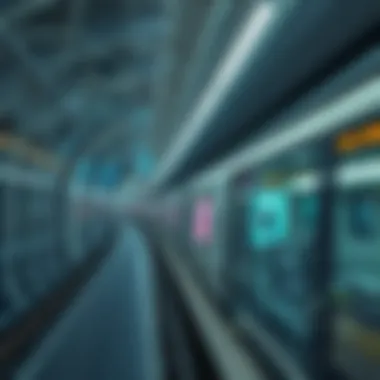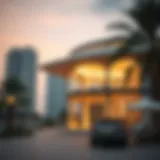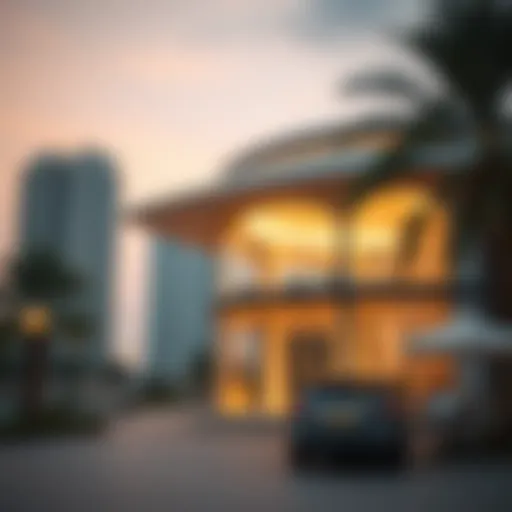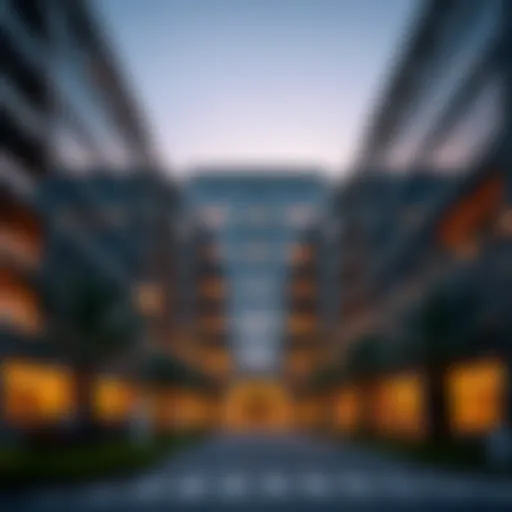Future Plans for the Dubai Metro: A Comprehensive Insight


Intro
As the glittering skyline of Dubai continues to evolve, the Dubai Metro stands as a testament to the city's relentless pursuit of modernity and efficiency. Originally inaugurated in 2009, the metro system transformed the way residents and visitors navigate the bustling city. With future ambitions on the horizon, it remains imperative to delve deep into the strategic plans that are set to reshape this iconic transportation method.
The Dubai Metro's expansion is not merely about extending rail lines; it's about reimagining urban mobility in an era of rapid change. There’s a growing awareness that effective public transport doesn’t just relieve congestion; it also greatly impacts the environment and fosters sustainable growth. This article aims to shed light on the intricate future plans for the Dubai Metro, exploring aspirations such as integrated transportation networks, technological advancements, and their broader implications for urban development.
Furthermore, city planners and investors alike need to stay attuned to the evolving landscape of the Dubai Metro and its surrounding infrastructure. With continuous investments and innovative projects on the table, the upcoming developments promise both challenges and opportunities. Our journey begins by analyzing current market trends, leading us to an exploration of investment opportunities in this dynamic environment.
Overview of the Dubai Metro System
The Dubai Metro is not just a mode of transport; it represents a monumental leap in urban transit and reflects the United Arab Emirates' commitment to innovation and sustainability. As we delve into its future plans, it’s important to understand the existing framework and how it lays the groundwork for expansion and technological progress.
The Metro was inaugurated in 2009, a decade later than the initial vision. In just a few years, it has become an essential artery for residents and visitors alike, dramatically reshaping how people navigate Dubai. With the sprawling desert city growing at breakneck speed, the Metro serves both immediate transportation needs and long-term urban planning goals.
Key features of the Dubai Metro include its high efficiency, cost-effective operation, and reduced environmental impact. It helps to lessen traffic congestion, cuts down on carbon emissions, and provides a reliable alternative to the often-chaotic Dubai roads. The system consists of two primary lines, the Red and Green Lines, which together boast a significant number of stations and connectivity across the city.
Understanding the current layout is critical for grasping future expansion plans. As the city grows, so does the demand for public transport that’s accessible and efficient. The Metro not only aids commuters but also enhances local businesses and tourism, creating a ripple effect of economic benefits.
"Public transport systems like the Dubai Metro are more than just transit; they're vital to a city's sustainability and livability—essential for a metropolis like Dubai."
The Metro is a perfect example of how integration can optimize urban functionality—bridging gaps between various city districts and providing easy access to major economic hubs. As we explore the history and milestones of the Dubai Metro in the next section, we can appreciate how foundational decisions have led to today’s achievements and how they set the stage for ambitious future plans.
Strategic Directions for Growth
The strategic directions for growth concerning the Dubai Metro are paramount in understanding how this innovative transportation system will shape the city's future. With the skyline of Dubai ever-evolving, focusing on key areas such as expansion and technological advancement will equip the metro to meet the increasing demands of a bustling metropolis. Understanding these strategies helps not only policymakers but investors, homeowners, and transportation analysts grasp the potential impact on urban mobility, real estate, and the economic landscape.
Expansion Plans
As the Dubai Metro gears up for its next phase, major expansion plans are in the pipeline. The vision includes extending existing lines and adding new routes which will effectively increase coverage across the city. Stakeholders agree this growth isn't merely about adding more tracks; it’s about enhancing the overall commuter experience.
- New Lines: Upcoming projects might include proposed extensions into the suburbs, improving access to residential areas, thus encouraging living beyond the immediate city center.
- Capacity Enhancements: Increasing the frequency of trains is also in consideration, allowing for a smoother flow of passengers during peak hours.
These expansions stand not only as a boon for daily commuters but also serve to boost tourism by providing tourists easier access to various attractions located throughout the city. Among other benefits, these plans should promote local businesses by directing more foot traffic their way.
Projected Timeline
The timeline for these expansion projects is designed with careful precision, allowing stakeholders to understand the different phases of the development. According to current sources, the key milestones will likely be as follows:
- Initial Feasibility Studies (2024): Initial assessments will be conducted to determine the viability of proposed routes.
- Procurement and Planning (2025-2026): Following feasibility approvals, contracts will be awarded to engineering firms and construction companies, setting the stage for groundwork.
- Construction Phase (2027-2030): If all goes according to plan, construction will begin. This phase includes a series of public consultations to ensure community input is incorporated.
- Testing and Commissioning (2031): Before the new lines officially open, they will undergo rigorous testing to ensure safety and efficiency standards meet Dubai’s high benchmarks.
These timelines reflect a commitment to thoroughness and precision that echoes the integrity of the overall Dubai Metro vision. As each step unfolds, it will significantly integrate with existing infrastructure, ensuring seamless transitions for commuters.
Technological Innovations on the Horizon
In the context of the Dubai Metro, technological innovations are not just an afterthought; they are at the heart of the future framework for urban transport systems. Integrating advanced technology into the metro's operations promises significant benefits, enhancing efficiency and commuter experience while aligning with the city's sustainability goals. From real-time tracking to automated train systems, these advancements stand to revolutionize how movement within the city is perceived and executed.
Smart Transportation Solutions
Smart transportation solutions are paving the way for a more connected and efficient travel experience. Features such as real-time data analytics, mobile app integrations, and IoT-based monitoring systems will transform how commuters interact with the Dubai Metro:
- Real-Time Data Integration: Riders can receive updates on train arrival times, delays, and service changes through mobile applications. This accessibility encourages efficient planning.
- Personalized Commuting: Using AI algorithms, the system could adapt to commuter patterns, enhancing services during peak times, thereby alleviating congestion.
- Automated Train Operations: Moving towards automation can lower operational costs while increasing safety and reliability. This aspect highlights a commitment to modernity with minimal human error in the transport process.
"The integration of smart technology in public transport isn't a matter of choice; it's a necessity for sustainable future."
These innovations bring pertinent questions about data security and privacy into the spotlight, as personal data will be crucial for tailoring these experiences. Ensuring robust data protection measures will be vital for fostering public trust in these advancements.
Sustainability Initiatives


Sustainability has become a buzzword recently, but its implications in the case of the Dubai Metro are far-reaching. The future plans encompass a range of initiatives designed to lower the carbon footprint of public transport:
- Energy-efficient Train Systems: Committing to modern electric trains will significantly reduce emissions compared to traditional systems.
- Solar Power Utilization: Integrating solar technology within metro stations not only reduces reliance on the grid but also sets a benchmark for renewable energy usage in urban transportation.
- Green Stations: Future designs aim to incorporate eco-friendly materials and methods in station construction, emphasizing the importance of reducing waste during transit operations.
Committing to these sustainability initiatives is likely to enhance the overall urban ecosystem's resilience, encouraging a shift in public sentiment towards eco-friendliness. It also serves as an attractive proposition for investors keen on funding projects with a commitment to environmental responsibility.
By focusing on these technological innovations and sustainability initiatives, the Dubai Metro not only aims to improve commuter experience and operational efficiency but also seeks to promote a broader dialogue about responsible urban development in the era of rapid globalization. This convergence of technology and sustainability ensures that the metro is not just a transit system, but a model for future cities.
Impact on Urban Mobility
In the heart of any bustling metropolis, effective urban mobility stands as a crucial pillar for sustaining growth and enhancing quality of life. For Dubai, a city known for its rapid development and ambitious projects, the evolution of the Dubai Metro system is instrumental in reshaping how residents and visitors traverse the urban landscape. Not only does the metro alleviate congestion, but it also plays an essential role in reducing the city’s carbon footprint.
Reducing Traffic Congestion
One of the primary goals of expanding the Dubai Metro is to significantly reduce the traffic congestion that plagues the city. As the population continues to swell, the roads have become increasingly clogged, especially during peak hours. According to estimates, one single Metro train can replace around 200 cars on the road. This not only diminishes the number of vehicles competing for limited road space, but it also contributes to smoother traffic flows.
Moreover, the increase in metro users can lead to a ripple effect. For instance:
- Less Time Stuck in Traffic: Commuters can spend more time focusing on work or leisure rather than battling traffic.
- Economic Benefits: By decreasing travel times, businesses can operate more efficiently, potentially leading to a boost in local economies.
- Increased Productivity: Studies indicate that people using public transportation tend to arrive at work less stressed and on time, fostering a healthier work environment.
The Metro also offers an obvious alternative to driving, making it nearly impossible to ignore for those facing the daily grind of Dubai’s traffic. Plus, the introduction of smart transportation solutions, as discussed in earlier sections, promises to improve traffic management even further, ensuring that the roads remain clear.
Enhanced Connectivity Between Districts
Improved connectivity through the Dubai Metro not only helps in reducing congestion but also vastly improves access to various districts across the city. Currently, many neighborhoods are somewhat isolated due to the extensive desert areas and the sprawling nature of the city. The expanded metro will stitch these areas together, ensuring that it becomes easier for residents to reach workplaces, shopping centers, and recreational spaces.
With the new extensions, one can anticipate changes such as:
- Access to Diverse Amenities: People from outlying areas will gain quicker and easier access to cultural sites, parks, and shopping malls, enriching community life.
- Encouragement of Mixed-Use Development: As connectivity improves, urban planners are likely to emphasize developing residential, commercial, and recreational spaces that encourage more sustainable living practices.
- Inclusivity: Improved transportation access can enhance mobility for those who may not own vehicles, such as students and low-income families, fostering equitable access to city resources.
In summary, enhancing urban mobility through the expansion of the Dubai Metro not only alleviates the pressure on roadways and improves overall traffic conditions, but also creates a framework for reinforcing social cohesion and economic vitality throughout the city.
Integration with Other Transportation Modes
The Dubai Metro does not operate in isolation; rather, it has become a linchpin in the city’s broader transportation strategy. Successfully blending various transport modalities is essential for maximizing efficiency and accessibility. The integration enhances not just the user experience but also optimizes network performance across the board, allowing for seamless transitions between different modes of transport.
Linking with the Dubai Tram System
The incorporation of the Dubai Tram system into the metro network is a significant leap towards a comprehensive public transport framework. Located in areas dense with both residential and commercial properties, the tram offers vital links to the metro. For instance, areas like Dubai Marina and Jumeirah Beach Residence have tram stations that connect directly to metro lines. This connection enables passengers to travel from one mode to the other without dragging their bags across busy streets or waiting for lengthy periods.
Moreover, the tram's lower operational costs and reduced carbon footprint complement the metro’s expansion plans effectively. Riders looking to explore the city's attractions can hop on the tram right after exiting the metro, simplifying journeys and thus creating a user-friendly atmosphere. Surveying public feedback reveals that many residents appreciate how these complementing systems allow them to navigate the bustling metropolis with ease.
"The seamless links between the metro and tram systems ensure that commuters can switch modes without any hassle—making public transit far more appealing to diverse populations."
Coordination with Bus Services
In tandem with the tram links, the bus services in Dubai are poised to further enhance the integration of transportation modes. With strategically placed bus stops near metro stations, travelers can easily hop onto different bus routes right after their metro journey. This setup is particularly advantageous for expanding access to neighborhoods that are not directly served by the metro.
Dubai's Roads and Transport Authority is known for its meticulous planning and has aimed to synchronize bus timetables with metro arrivals. This practical approach reduces wait times significantly—for instance, the average wait time for buses is commonly less than ten minutes after a train arrives.
When a city can harness the strengths of its various transport networks, it stands to benefit economically as well. Improved connectivity can boost local business activities, as customers can reach stores and services more conveniently. Additionally, enhancing the public transport systems can lighten the load on roadways, reducing congestion and offering environmental benefits that residents are keen on.
Overall, the ongoing coordination and planning between the metro, tram, and bus services show a promising future for public transport in Dubai. It strengthens the infrastructure while making travel more convenient, efficient, and environmentally friendly.
Potential Economic Impacts
The future of the Dubai Metro isn't just about trains running on tracks; it's a thread interwoven with the economic fabric of the city. The potential economic impacts of expanding the metro system are wide-ranging and significant. As the city progresses, understanding these impacts helps elucidate the broader implications for businesses and residents alike.


Boosting Local Business
One of the anticipated benefits of the metro expansion is the boost to local businesses. Imagine how a well-connected transportation network can drive foot traffic to shops, cafes, and various enterprises along its routes. Increased accessibility often translates into higher customer volumes. For neighborhood businesses, this surge can be the difference between thriving and merely surviving.
- Localized Growth: Areas surrounding metro stations could transform into vibrant commercial hubs. Small businesses and startups might find a perfect opportunity to flourish, tapping into the flow of commuters.
- Tourism Draw: With Dubai being a hotspot for tourists, a revamped metro system may simplify the travel experience. This ease of access could encourage more visitors to explore local attractions, propelling sales for businesses that cater to tourists.
However, it's essential to consider that merely having a metro station is not a silver bullet. Business owners must adapt to shifting demographics and consumer behavior. A local shop serves the community best by understanding its patrons and aligning offerings to meet their needs, while also leveraging the increased visibility from passing commuters.
Implications for Real Estate Development
The update and expansion of the Dubai Metro are expected to influence real estate development directly. Areas close to metro stations typically see an upswing in property values. Developers and investors are always on the lookout for prime locations, and proximity to a metro station is often a key factor in determining desirability.
- Rising Property Values: Over time, properties near metro stations may witness an appreciation in their values. This potential uplift incentivizes investment in both residential and commercial sectors, creating a cycle of growth.
- Urban Sprawl Management: As the metro expands into suburban areas, it can help manage urban sprawl, pressing developers to think creatively about land use. Higher density developments might become more common, which can create more affordable housing opportunities.
Moreover, there's a broader strategy behind these land uses. City planners have the task of ensuring that development adds to the community’s character and functionality while meeting housing demands. This calls for a delicate balance between growth, sustainability, and livability.
Challenges and Considerations
Understanding the challenges and considerations surrounding the future plans for the Dubai Metro is crucial for various stakeholders, from urban planners to investors. As Dubai navigates its ambition for a world-class public transportation system, it faces hurdles that could impact its goals and the overall effectiveness of the Metro. Addressing these challenges not only ensures the Metro's success but also facilitates Dubai's broader urban development objectives.
Funding and Investment Challenges
Securing adequate funding is a primary hurdle in the expansion of the Dubai Metro. The cost of developing a comprehensive metro system is daunting, often running into billions of dirhams. To illustrate, the recently completed Route 2020 project, which extended the metro to the Expo 2020 site, had an estimated budget exceeding 10 billion dirhams. This extensive investment raises the question of how future projects will be financed.
Developers and investors must weigh the risks and rewards. Potential funding sources could include government allocations, private investments, and international loans. However, relying heavily on public funds may strain Dubai's budget, especially post-pandemic. Key considerations for funding include:
- Public-Private Partnerships (PPPs): Collaborating with private firms could relieve some financial pressure. However, structuring these partnerships must align with public interests.
- Global Economic Conditions: Investors closely watch global market trends, financial stability, and interest rates, which can affect their willingness to invest further.
- Return on Investment (ROI): There must be clear projections regarding how investments will translate into economic benefits, whether through increased ridership or boosted commercial activity near stations.
In summary, navigating the maze of funding and investment is essential for the sustainability of the Metro's expansion. Without strategic financial solutions, ambitious plans may stall.
Technological Hurdles
Another significant consideration is the technological hurdles that lie ahead. The willingness to incorporate cutting-edge technology can propel the Dubai Metro into a future of efficiency and reliability. However, integrating advanced systems presents its own set of challenges.
For example, implementing smart transportation solutions like real-time tracking or automated payment systems requires substantial investment in both infrastructure and training. Certain key points to consider include:
- Compatibility with Existing Systems: Upgrading technology without disrupting current operations demands meticulous planning. Any misstep could lead to service interruptions that frustrate commuters.
- Training and Adaptation: Personnel need to be trained to handle new technologies. This includes everything from operating smart systems to maintaining them long-term.
- Cybersecurity Risks: Expanding digital capabilities opens new doors for cyber threats. Focusing on robust cybersecurity measures is necessary to protect against potential breaches that could compromise data and operational integrity.
In essence, tackling technological challenges head-on can be the difference between a futuristic metro system and one that struggles to meet basic operational demands. Embracing these upgrades can enhance user experience and ensure that the Dubai Metro remains a benchmark in urban transit.
"Navigating the complexities of funding and technology is essential for transforming the Dubai Metro into a leading public transport system that meets the needs of its users and the city’s ambitions."
For further resources on urban transit strategies, you can explore Wikipedia on Urban Transport, Britannica’s article on Transportation, and various discussions on Reddit about Public Transport.
Urban Planning and Development Synergy
In any growing metropolis like Dubai, the integration of urban planning and transportation development is crucial. The synergy between these two elements is not just beneficial; it's essential for the city's sustainable growth and livability. The Dubai Metro, with its ambitious expansion plans, offers an opportunity to redefine how urban spaces are structured and utilized.
The collaboration between urban planners and transportation experts yields multiple benefits. First, it allows for the alignment of infrastructure development with demographic shifts and economic trends. As the population swells and new districts are developed, the transport system must evolve to meet changing demands. Without this synergy, we risk creating bottlenecks and inefficiencies that can stymie growth.
Also, well-planned transportation systems can enhance access to essential services, thus improving quality of life for residents. By situating metro stations strategically, planners can connect residential areas with hospitals, schools, and workplaces, making daily commutes hassle-free. Moreover, effective transport links can encourage higher foot traffic in business districts, ultimately benefiting local economies.
Collaborative Urban Strategies
A key aspect of ensuring a successful integration of the Dubai Metro within urban planning is collaborative urban strategies. Stakeholders from various sectors must come together, pooling their knowledge and resources to create a cohesive strategy.
- Stakeholder Engagement: Regular meetings and workshops involving developers, government agencies, and community groups can pave the way for transparent communication. This ensures that transportation plans reflect the needs and aspirations of the diverse communities within Dubai.
- Shared Vision: Establishing a common vision helps to streamline efforts and resources. The future of the Dubai Metro should not only be about rail expansion but also about enhancing the entire urban landscape. By embedding this vision in urban policies, planners can cultivate a holistic approach to transportation and land use.
- Urban Design Integration: Incorporating transit-oriented development (TOD) principles into urban design plays a vital role. This means creating walkable neighborhoods that are close to transit facilities. It helps in reducing the need for private vehicles, thus cutting road congestion and improving air quality.


Future Land Use Implications
The future land use implications of the expanding Dubai Metro are significant. The growth of this transportation network will profoundly impact how land is allocated and utilized throughout the city.
- Increased Density: Areas surrounding metro stations are likely to experience higher development densities. This can lead to vertical growth, where buildings rise higher to accommodate more residents and businesses. As density increases, it creates a vibrant urban environment conducive to commerce and social interaction.
- Mixed-Use Developments: The expansion opens avenues for mixed-use developments, where residential, commercial, and recreational spaces coexist. This planning method fosters a sense of community and reduces travel times as people can live, work, and play in closer proximity.
- Green Spaces: Future development plans also emphasize the importance of green spaces. By incorporating parks and recreational areas near transit hubs, urban planners can promote healthier lifestyles and environmental sustainability. This is crucial for countering the urban heat island effect prevalent in desert cities like Dubai.
"Transportation infrastructure is not just about moving people; it's about shaping communities and creating livable spaces."
For more on transportation impacts on urban environments, consider visiting Wikipedia or Britannica.
This robust connection between transport and urban planning not only redefines how residents navigate their city. It's instrumental in molding the landscape of Dubai for decades to come.
Societal Reactions and Public Perception
Understanding societal reactions and public perception around the Dubai Metro's future plans is of paramount importance. This topic sheds light on how residents, commuters, and various stakeholders view the ongoing changes in their public transportation system. Their sentiments can play a crucial role in shaping the success of any new implementations or expansions.
Community Feedback and Involvement
Community feedback often serves as the backbone for assessing the public’s satisfaction and willingness to adapt to new systems. In Dubai, residents are not just passive observers; they actively engage in discussions about their urban infrastructure. The government has established multiple channels for feedback, ranging from social media platforms to public consultations.
For instance, socials like Facebook and Reddit are buzzing with discussions on everything from metro extensions to proposed service enhancements. Surveys conducted through various platforms have shown that many residents and commuters value accessibility and speed in their public transport.
- Benefits of Community Involvement:
- Allows for real-world input that can influence planning.
- Provides a sense of ownership among residents.
- Fosters transparency and trust between the authorities and the public.
The enormity of public input cannot be understated. Not only does it help authorities refine their strategies, but it also ensures that the changes being implemented resonate well with the community’s evolving needs.
Public Skepticism and Trust Issues
Despite significant benefits, skepticism still lingers among certain segments of the population. Many voices express concerns regarding the reliability of promises made about improvements in service and punctuality. Past instances where expected enhancements fell short amplify these doubts. People tend to remember experiences tied to delays or service outages, leading to a cautious approach towards new announcements.
Moreover, trust issues can also emerge from factors like perceived lack of transparency or investment mismanagement. Addressing these concerns openly is vital.
- Common Points of Skepticism:
- Will the new expansions truly meet the promised timelines?
- Are the investments being utilized effectively for the community’s benefit?
Public perception isn't static; it fluctuates depending on how effectively stakeholders engage with the community. Authorities can alleviate skepticism by emphasizing transparency in their operations and explicitly detailing the expected benefits of future projects.
"The community’s voice matters, and it's essential for shaping the Dubai Metro into a system that everyone can rely on."
By regularly reviewing feedback and acting on it, the Dubai Metro authorities can build a stronger relationship with commuters, turning skepticism into trust and support.
Finale and Future Outlook
The future of the Dubai Metro presents a compelling narrative woven into the city's urban fabric. As this article has discussed, the plans for expansion, technological innovation, and integration with other transportation systems underscore a profound commitment to enhancing mobility within the city. This conclusion synthesizes the critical elements addressed throughout the article, highlighting the significance of these developments for a broad audience, notably investors, homeowners, agents, and analysts.
Summary of Key Points
Throughout this exploration, several key points have emerged that underline the importance of the Dubai Metro's future:
- Strategic Expansion: The planned extension of the metro network not only responds to current demand but anticipates future growth in population and commerce. This proactive approach is vital for sustaining economic vibrancy.
- Technological Innovations: The shift towards smart transportation solutions reflects the embrace of technology that enhances efficiency and user experience. This moves beyond mere convenience to touch on broader issues like sustainability and energy efficiency.
- Integration Efforts: Tying the metro system with other transport modes, such as the tram and bus networks, sets a precedent for seamless urban mobility. This interconnectedness will significantly alleviate road congestion and promote use of public transportation.
- Community Engagement: Understanding the public's perceptions and feedback is paramount. Addressing skepticism and promoting transparency fosters trust, which is essential for the successful implementation of urban projects.
By identifying and emphasizing these points, we grasp the multi-faceted impact of the Dubai Metro on urban life.
Vision for the Future of Urban Transport
Looking towards the future, the vision for the Dubai Metro is bold and transformative. The following factors encapsulate this scope:
- Sustainable Urban Development: As environmental issues grow pressing, the integration of eco-friendly practices for the metro development and operations will be crucial. This includes utilizing renewable energy, reducing carbon footprints, and promoting green spaces in urban areas surrounding metro stations.
- Enhanced User Experience: Future plans indicate a focus on improving not just the infrastructure but also the customer experience. This entails modern amenities like better waiting areas, real-time information displays, and well-designed ticketing systems.
- Economic Catalyst: Taken as a whole, the developments in the Dubai Metro are expected to spur economic growth. They attract investments in real estate, promote local businesses, and enhance property values, directly impacting the quality of life in Dubai.
- Future-Ready Technology: Anticipating emerging technologies will be necessary. Adaptive systems, real-time data analytics, and even AI integrations might be common, serving both operational needs and passenger expectations.
The journey of the Dubai Metro is not merely about transport; it's about shaping the very essence of urban living in one of the world’s most dynamic cities.
In summation, the outlook for the Dubai Metro is optimistic. With its array of initiatives designed to foster growth, mitigate congestion, and embrace sustainability, the subsequent chapters of this urban story promise to build on its already significant legacy.















